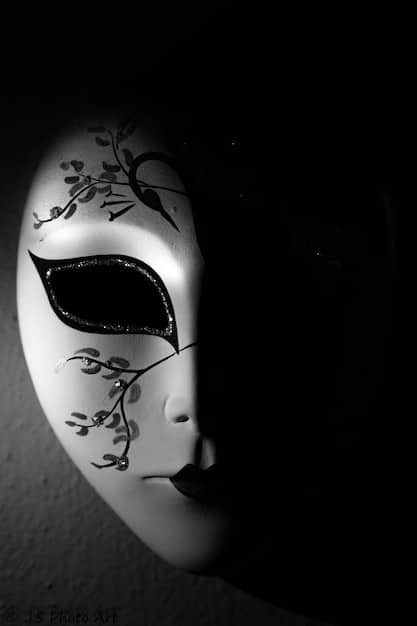The evolution of dramatic storytelling: a comprehensive review

The landscape of dramatic storytelling has undergone a profound evolution, moving from classic stage performances to complex cinematic narratives and modern streaming series, reflecting societal shifts and technological advancements that shape how audiences engage with emotionally resonant content.
In a world saturated with content, understanding the nuances of dramatic storytelling has become more critical than ever. From the grand narratives of ancient Greece to the intricate psychological dramas gracing our screens today, the genre has consistently served as a mirror reflecting the human condition. This exploration delves into the fascinating evolution of drama reviews, examining how the art of critique has adapted to keep pace with the ever-changing forms and platforms through which dramatic narratives are delivered.
The foundations of dramatic criticism
Dramatic criticism is not a modern invention; its roots trace back to antiquity, where philosophers and scholars pondered the purpose and impact of theatrical performances. Aristotle’s Poetics, for instance, laid down fundamental principles that still resonate with contemporary critics. His analysis of plot, character, thought, diction, song, and spectacle provided a framework for understanding the essential elements of tragedy and, by extension, drama as a whole.
Early forms of criticism were often prescriptive, guiding playwrights on how to achieve catharsis or moral instruction. Reviewers, often influential figures of their time, held considerable sway over public opinion and the success of new works. Their critiques were less about personal taste and more about adherence to established artistic and moral conventions. This era set the precedent for what a drama review fundamentally aims to do: evaluate and contextualize a performance or text for an audience.
From stage to page: the print era of reviews
The advent of print media revolutionized dramatic criticism, transforming it from an oral or limited-edition practice into a widespread phenomenon. Newspapers and literary journals became primary vehicles for publishing reviews, making them accessible to a broader section of society. This democratization of criticism brought new voices and perspectives, marking a shift towards more descriptive and analytical reviews.
- Detailed analysis: Reviewers began to dissect plots, character development, and directorial choices with greater depth.
- Personal interpretation: While still grounded in principles, individual critical voices became more pronounced, offering unique insights.
- Audience engagement: Reviews helped shape public discourse, influencing attendance and reputation of productions.
During this period, the role of the drama critic solidified as an arbiter of taste and a guide for theatergoers. Their reviews became essential reading for anyone interested in the performing arts, often sparking debates and elevating certain productions to legendary status, or consigning others to obscurity. This era established many of the conventions we still see in traditional drama reviews today, emphasizing clarity, conciseness, and persuasive argumentation.
The evolution from ancient philosophical treatises to printed reviews underscores a continuous effort to grapple with the power of dramatic art. These early critics, whether philosophers or journalists, understood that drama was more than mere entertainment; it was a reflection of society, a tool for moral instruction, and a powerful medium for emotional expression. Their legacy lives on in the methodologies and discussions that inform contemporary drama reviews, providing a crucial historical context for understanding their present form and future trajectory.
The cinematic revolution and its impact on criticism
The early 20th century heralded a monumental shift in dramatic storytelling: the birth of cinema. Film introduced an entirely new canvas for narratives, complete with its own unique aesthetic possibilities and technical challenges. This transition naturally necessitated an evolution in dramatic criticism, moving beyond the confines of stage performance to embrace the moving image.

Film critics emerged as a specialized group, often drawing from literary and theater criticism but adapting their craft to the distinct language of cinema. New terminologies and analytical frameworks were developed to assess elements like cinematography, editing, sound design, and the performances of actors on screen, which differed significantly from stage acting. The narrative structures also became more complex, utilizing techniques like flashbacks, parallel narratives, and non-linear storytelling that were less common in traditional theater.
The golden age of film criticism
The mid-20th century is often considered the golden age of film criticism, with influential figures like Pauline Kael, Andrew Sarris, and Roger Ebert shaping public perception and elevating film analysis to an art form. Their reviews were not just summaries; they were thoughtful essays that explored themes, directorial intent, and the cultural significance of movies.
- Auteur theory: The idea that the director is the primary author of a film gained prominence, shifting focus to their unique vision.
- Sociopolitical commentary: Critics increasingly analyzed films through a lens of social and political relevance, reflecting contemporary issues.
- Accessibility and influence: Reviews published in major newspapers and magazines reached millions, guiding audiences and influencing awards.
The accessibility of cinema, especially with the rise of television, meant that film reviews had a broader and more immediate impact than ever before. A positive review from a respected critic could boost a film’s box office success, while a negative one could signal its demise. This period laid the groundwork for how we critically engage with visual narratives, emphasizing both the artistic merit and the cultural resonance of a work.
The introduction of cinema expanded the very definition of drama, creating a new set of formal and thematic challenges for critics. While the core questions of storytelling — character, plot, emotion — remained, the tools for their expression and evaluation multiplied. This enrichment of the critical landscape meant that drama reviews had to become more versatile, encompassing a wider range of artistic practices and their unique demands.
The digital age: streaming, social media, and new voices
The turn of the millennium, propelled by rapid technological advancements, ushered in the digital age, irrevocably transforming how we consume and review dramatic content. The advent of high-speed internet, coupled with the rise of streaming platforms, decentralized content distribution and democratized the act of criticism itself. Gone are the days when a handful of established critics held almost exclusive sway over public opinion. Now, everyone with an internet connection can be a reviewer.
Streaming services like Netflix, Hulu, and Amazon Prime Video have flooded the market with an unprecedented volume of original and licensed content. This “content explosion” means that traditional print-focused critics simply cannot cover everything. This void has been filled by a diverse array of new voices: bloggers, YouTubers, podcasters, and social media influencers, each catering to niche communities and offering unique perspectives on dramatic works.
The rise of Rotten Tomatoes and Metacritic
Platforms like Rotten Tomatoes and Metacritic have become crucial aggregators of critical opinion. These sites compile reviews from a multitude of sources, assigning scores that provide a quick snapshot of a film or TV show’s reception. While immensely popular for their ease of use, they have also sparked debate about the reduction of complex critical thought to a simple numerical average or “fresh” versus “rotten” rating. This aggregation, however, offers a valuable initial data point for many viewers curious about a new release.
- Democratization of criticism: Anyone can publish a review, leading to a wider range of opinions and accessibility.
- Immediate feedback loops: Social media allows for instant reactions and discussions, fostering vibrant online communities.
- Micro-influencers: Niche critics gain significant followings by specializing in specific genres or themes.
The digital landscape has also intensified the speed at which reviews are published and consumed. Spoilers become a major concern, and the race to be the first to publish a review can sometimes impact the depth of analysis. Yet, the dynamism of online discourse means that discussions around drama are more robust and multifaceted than ever before, encompassing fan theories, deep dives into character motivations, and interactive debates.
This shift from centralized, authoritative critical voices to a decentralized, user-generated landscape profoundly impacts how drama reviews are perceived and utilized. While it presents challenges in discerning credible analysis from noise, it also fosters a richer, more diverse conversation, enabling audiences to discover content and perspectives that might never have reached them in a pre-digital era.
E-E-A-T and the future of drama reviews
In the vast, often overwhelming, ocean of digital content, search engines like Google are constantly refining their algorithms to prioritize high-quality, trustworthy information. This led to the emphasis on E-E-A-T: Experience, Expertise, Authoritativeness, and Trustworthiness. For drama reviews, adhering to E-E-A-T principles is no longer just good practice; it’s essential for visibility and credibility in an increasingly crowded online space.
An experienced reviewer might have watched hundreds of films, attended countless theatrical productions, and tracked director filmographies for decades. Their history of interaction with the art form lends weight to their opinions. Expertise comes from a deep understanding of cinematic or theatrical techniques, narrative theory, industry trends, and cultural contexts. This allows a critic to move beyond surface-level observations to provide insightful, well-informed analysis.
Building authority and trustworthiness
Authoritativeness in drama reviews is built through a consistent track record of accurate, thoughtful, and well-researched critiques that are recognized and referenced by others in the field. This could involve being published in reputable outlets, receiving industry accolades, or simply being frequently cited by other critics and academics. Trustworthiness, perhaps the most crucial element, is about transparency, objectivity (as much as possible in subjective art forms), and a commitment to factual accuracy.
- Transparency: Disclosing potential conflicts of interest or biases.
- Evidence-based critique: Supporting interpretations with specific examples from the work.
- Corrections and updates: A willingness to correct errors or update reviews if new information emerges.
The future of drama reviews will likely see a greater emphasis on professional and independent critics who can demonstrate robust E-E-A-T. While user-generated reviews will continue to thrive, there will be a growing need for curators and critics who can cut through the noise, providing reliable and deeply analytical perspectives that audiences can trust. This means moving beyond quick takes and shallow summaries to offer reviews that enrich the reader’s understanding and appreciation of the dramatic art form.
The digital age requires a new kind of gatekeeper – not one who restricts access, but one who guides users to quality, helping them navigate the vast content landscape. For drama reviews, this means critics who are not only passionate and insightful but also demonstrably credible, offering reviews that stand as authoritative beacons in a sea of diverse opinions.
The evolving language and style of reviews
Just as dramatic forms evolve, so too does the language and style of their reviews. From the formal, often academic tone of early theater critics to the more conversational and personalized style prevalent online, the medium of criticism constantly adapts. This evolution reflects broader changes in communication, audience expectations, and the very nature of engagement with artistic content.
In the past, a drama review might have been a lengthy, scholarly essay, perhaps published days or even weeks after a premiere. The language would often be sophisticated, referencing classical works and philosophical concepts. Critics saw themselves as educators, guiding the audience toward a deeper aesthetic appreciation. Today, while scholarly deep dives still exist, there’s a strong demand for more accessible, immediate, and often entertaining reviews.
The rise of conversational and accessible prose
Modern drama reviews, especially those found online, tend to adopt a more conversational tone, mirroring the way friends might discuss a show. This doesn’t necessarily mean a reduction in intellectual rigor, but rather a shift towards engaging the reader directly, using more relatable language and a sense of shared experience. The goal is often not just to inform, but to spark a dialogue.
- Relatability: Using language that resonates with a broad audience, avoiding jargon.
- Personal connection: Infusing a review with the critic’s unique voice and perspective.
- Engagement: Encouraging comments, discussions, and reader participation.
The integration of multimedia elements has also changed how reviews are crafted. A text review might now be accompanied by video snippets, image galleries, or embedded social media conversations. Podcasting and video essays offer entirely new formats for dramatic criticism, allowing critics to use sound, visuals, and dynamic editing to convey their points in ways text alone cannot.
The best contemporary drama reviews manage to balance accessibility with depth, offering thoughtful analysis without alienating the general reader. They understand that while a review informs, it also entertains and inspires, maintaining the critical distance necessary for objective analysis while embracing the passion inherent in discussing dramatic art. This adaptability in style ensures that drama reviews remain relevant and engaging to diverse audiences across various platforms.
The symbiotic relationship: creators, critics, and audiences
The ecosystem of dramatic storytelling thrives on a complex and often intertwined relationship between creators, critics, and audiences. Far from being isolated entities, each group influences and shapes the others, contributing to the overall health and evolution of the dramatic arts. This dynamic interplay is crucial for the continuous development and appreciation of new works.
Creators, whether playwrights, directors, or screenwriters, pour their vision into their work, aiming to evoke emotion, provoke thought, or simply entertain. For them, critics serve multiple roles: they act as initial audience surrogates, offering early feedback; they provide publicity, drawing attention to a new production; and they contribute to the historical record, documenting the impact and legacy of a work. While not always directly agreeable, critics offer a mirror through which creators can see their work from an informed external perspective, sometimes even influencing future creative choices.
The audience as a critical force
Audiences are the ultimate beneficiaries and, increasingly, active participants in this ecosystem. Their engagement, measured by box office success, streaming numbers, or social media buzz, directly influences what content gets produced. Moreover, with the rise of user reviews and fan communities, the audience itself has become a powerful critical force, capable of catapulting a niche show to global popularity or vocally expressing dissatisfaction with a major release. This feedback loop, though sometimes chaotic, can be incredibly valuable.
- Direct feedback: Immediate reactions from social media and user reviews.
- Shifting tastes: Audience preferences influence commissioning decisions for new dramas.
- Community building: Online forums and discussion groups foster deeper engagement with content.
Critics, positioned between creators and audiences, play a mediating role. They interpret creative intent for the public, contextualize works within broader artistic movements, and help audiences navigate the vast landscape of available content. A thoughtful drama review doesn’t just pass judgment; it enriches the viewing experience, providing insights that might have been otherwise missed and encouraging deeper reflection on the themes and techniques employed. This symbiotic relationship ensures that dramatic storytelling remains a vibrant, evolving art form, continually responsive to both artistic innovation and societal resonance.
Ethical considerations in drama reviews
As the landscape of drama reviews becomes more diverse and accessible, ethical considerations gain increasing importance. The power of a review, especially in the digital age, to influence public perception and the financial success of a production, necessitates a strong adherence to ethical guidelines. Responsible criticism goes beyond mere opinion; it involves a commitment to fairness, accuracy, and professional integrity.
One primary ethical concern is bias. Critics, like all humans, have personal preferences and unconscious biases. However, professional reviewers strive for objectivity, or at least transparency about their perspectives. This includes avoiding conflicts of interest, such as reviewing a project in which one has a financial stake or a close personal relationship with a creator. Disclosing such connections, even if subtle, helps maintain trustworthiness with the audience.
Navigating spoilers and sensationalism
Another significant ethical challenge is the handling of spoilers. In an age of instant gratification and pervasive online discussion, a single careless sentence in a review can ruin a major plot twist for countless viewers. Responsible critics exercise extreme caution, either avoiding spoilers entirely or clearly tagging them with warnings, allowing readers to decide if they want to proceed.
- Avoiding personal attacks: Focusing critique on the work, not the individuals involved.
- Fact-checking: Ensuring all factual claims within a review are accurate.
- Balancing praise and critique: Providing a balanced assessment, even for works one strongly dislikes or loves.
The temptation for sensationalism, particularly in the competitive online environment, can also be a pitfall. While catchy headlines and strong opinions can attract clicks, resorting to exaggeration or misleading statements undermines the credibility of the review and the critic. Ethical reviews prioritize genuine analysis over clickbait. Maintaining high ethical standards ensures that drama reviews serve as a reliable and valuable resource, fostering informed engagement with dramatic art rather than simply contributing to online noise. This commitment to integrity benefits creators, audiences, and the art form itself, building a foundation of trust essential for sustained critical discourse.
| Key Aspect | Brief Description |
|---|---|
| 🎭 Historical Roots | Drama reviews began with ancient philosophers, evolving into modern critiques. |
| 🎬 Cinema’s Influence | Film introduced new critical elements like cinematography and editing. |
| 🌐 Digital Shift | Streaming and social media democratized and diversified reviews. |
| ⚖️ Ethical Standards | Crucial for maintaining integrity and trust amidst a flood of opinions. |
Frequently asked questions about drama reviews
▼
An effective drama review offers insightful analysis, clear argumentation, and contextual understanding. It balances subjective opinion with objective observations about plot, character, direction, and technical merits. Such reviews help readers appreciate the work more deeply, regardless of whether they agree with the final judgment.
▼
Social media has democratized and accelerated drama reviews, allowing for immediate public reaction and diverse voices. While it increases accessibility, it also poses challenges in terms of distinguishing credible analysis from casual opinions and managing spoiler culture. This shift fosters more dynamic, widespread discussion.
▼
E-E-A-T stands for Experience, Expertise, Authoritativeness, and Trustworthiness. It’s crucial for drama reviews because it helps search engines and readers identify high-quality, reliable criticism in a saturated online environment. Reviews adhering to E-E-A-T are perceived as more credible and valuable.
▼
Yes, drama reviews can significantly influence a production’s success, particularly traditional, well-regarded critical outlets. Positive reviews often boost ticket sales and viewership, while negative ones can hinder them. In the digital age, aggregated scores (like Rotten Tomatoes) and viral social media discussions also play a substantial role in influencing public perception and success.
▼
Critics should be mindful of biases, avoid conflicts of interest, and be transparent about their perspectives. Handling spoilers responsibly by using warnings or avoiding them is crucial. Additionally, maintaining accuracy, avoiding sensationalism, and focusing critique on the work itself rather than personal attacks are vital ethical practices.

Conclusion
The journey of drama reviews, from Aristotle’s ancient poetics to the bustling digital forums of today, reflects a continuous human impulse to understand, evaluate, and share the impact of storytelling. This evolution is not merely a change in format or platform but represents a deeper transformation in how we interact with, interpret, and disseminate opinions about dramatic art. The future will undoubtedly bring further innovations, challenging critics and creators alike to adapt to new technologies and evolving audience expectations. Yet, the core purpose of a drama review—to provide insight, context, and a valuable perspective on the timeless art of dramatic narratives—will remain an indispensable bridge between the stage, the screen, and the captivated viewer.





